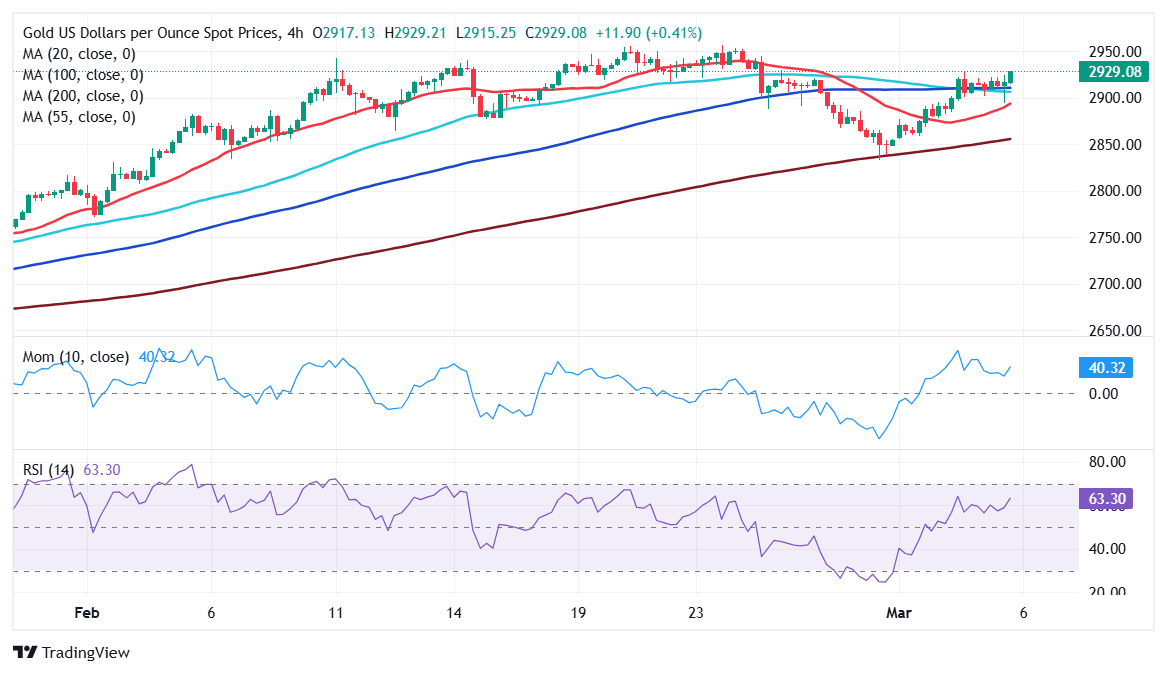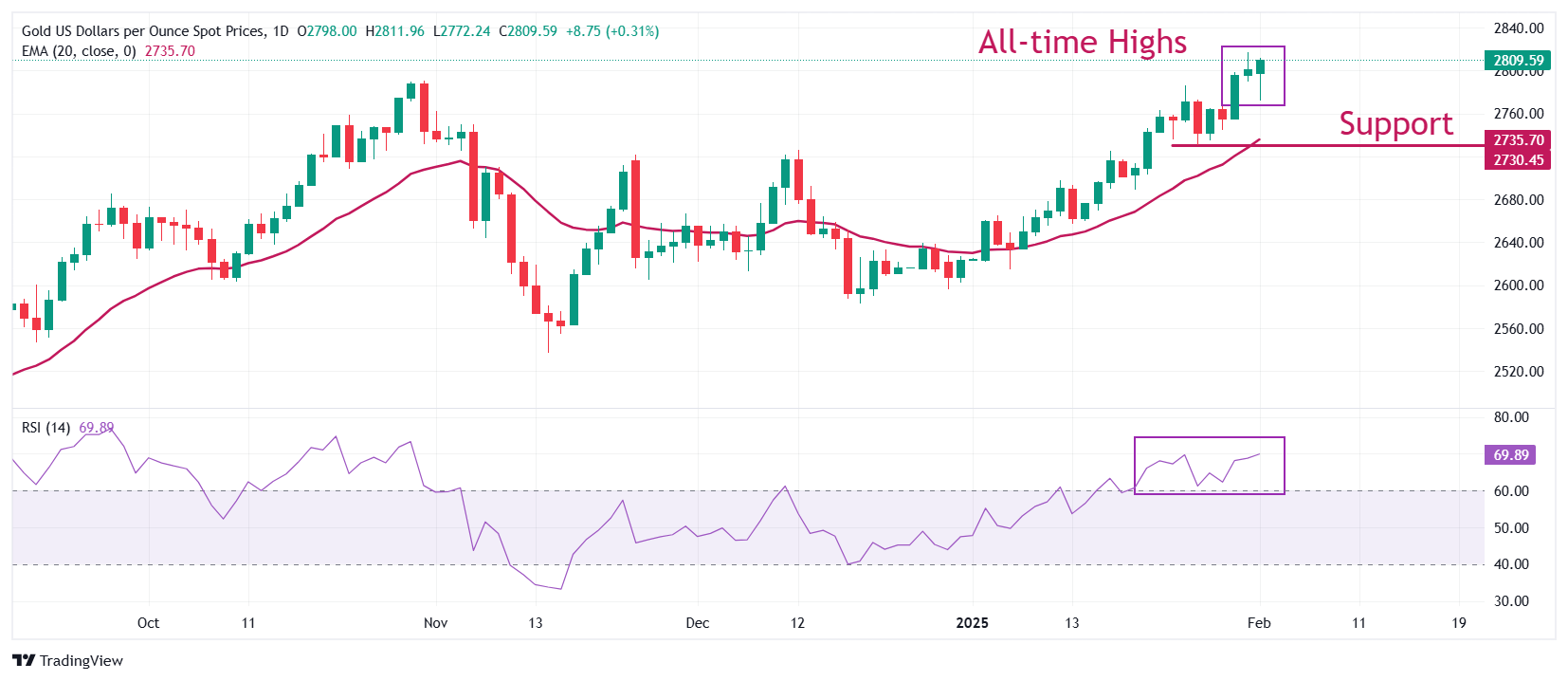- Analytics
- News and Tools
- Quotes
- Chart and quotes for XAUUSD
Quotes and rates for precious metals Gold vs US Dollar (XAUUSD)
| Date | Rate | Change |
|---|
Related news
-
19.03.2025 18:17Gold Price Forecast: XAU/USD lurches to $3,040 post-Fed
- Gold bids jump after Fed releases latest rate call and dot plot.
- Growth expectations in 2025 are getting hampered by lopsided US policy calls.
- Markets await Fed Chair Powell's latest press conference.
On Wednesday, Gold surged, reaching $3,040 during intraday trading as the Federal Reserve (Fed) made its latest interest rate decision, keeping rates unchanged at 4.5%. While markets generally anticipated this hold, any modifications to the Fed's outlook could unsettle investors who are awaiting comments from Fed Chair Jerome Powell.
The Fed noted that growth projections for 2025 have been significantly hindered by the Trump administration's erratic policy of announcing trade tariffs on social media only to later retract them. As a result, the Federal Open Market Committee (FOMC) revised its end-2025 Gross Domestic Product (GDP) forecast to 1.7%, a sharp decline from the 2.1% estimate shared in December.
Additionally, the median dot plot suggests the end-2025 interest rate will remain at 3.9%, showing little change since the last policy meeting. The FOMC plans to slow down its balance sheet runoff starting in April. Rate markets still indicate a greater than 50% chance of a quarter-point rate cut in June, although the likelihood has slightly decreased, with 42% of traders expecting rates to stay the same.
More to come...
-
18.03.2025 02:21Gold Price Forecast: XAU/USD rises above $3,000 to record highs amid safe-haven demand
-
17.03.2025 00:57Gold Price Forecast: XAU/USD holds positive ground near $3,000 on safe-haven demand
-
17.03.2025 00:57Gold Price Forecast: XAU/USD holds positive ground near $3,000 on safe-haven demand
-
10.03.2025 01:05Gold Price Forecast: XAU/USD holds above $2,900 amid global uncertainty, weaker US job data
-
05.03.2025 16:27Gold Price Forecast: XAU/USD trades around $2,930 amid escalating trade war
-
03.03.2025 00:41Gold Price Forecast: XAU/USD drifts higher above $2,850 amid the cautious mood
-
03.03.2025 00:41Gold Price Forecast: XAU/USD drifts higher above $2,850 amid the cautious mood
-
27.02.2025 00:36Gold Price Forecast: XAU/USD holds positive ground above $2,900 amid renewed US tariff threats
-
27.02.2025 00:36Gold Price Forecast: XAU/USD holds positive ground above $2,900 amid renewed US tariff threats
-
24.02.2025 01:16Gold Price Forecast: XAU/USD attracts some sellers below $2,950 on profit-taking
-
17.02.2025 00:12Gold Price Forecast: XAU/USD drifts lower below $2,900 amid profit-taking
-
10.02.2025 00:11Gold Price Forecast: XAU/USD extends upside above $2,850 on trade war tensions, China’s buying
-
03.02.2025 13:46Gold Price Forecast: XAU/USD recovers above $2,800 as USD gives up some gains
-
03.02.2025 00:44Gold Price Forecast: XAU/USD drifts lower below $2,800 after Trump imposes tariffs
© 2000-2025. All rights reserved.
This site is managed by Teletrade D.J. LLC 2351 LLC 2022 (Euro House, Richmond Hill Road, Kingstown, VC0100, St. Vincent and the Grenadines).
The information on this website is for informational purposes only and does not constitute any investment advice.
The company does not serve or provide services to customers who are residents of the US, Canada, Iran, The Democratic People's Republic of Korea, Yemen and FATF blacklisted countries.
Making transactions on financial markets with marginal financial instruments opens up wide possibilities and allows investors who are willing to take risks to earn high profits, carrying a potentially high risk of losses at the same time. Therefore you should responsibly approach the issue of choosing the appropriate investment strategy, taking the available resources into account, before starting trading.
Use of the information: full or partial use of materials from this website must always be referenced to TeleTrade as the source of information. Use of the materials on the Internet must be accompanied by a hyperlink to teletrade.org. Automatic import of materials and information from this website is prohibited.
Please contact our PR department if you have any questions or need assistance at pr@teletrade.global.

















